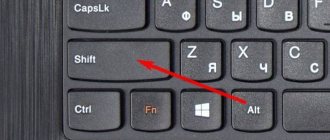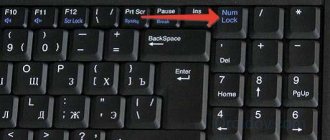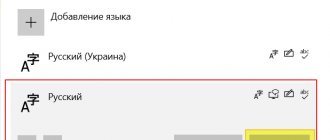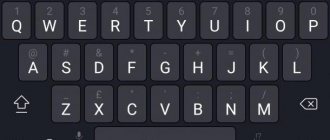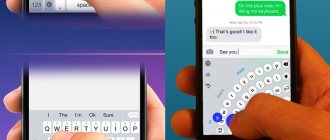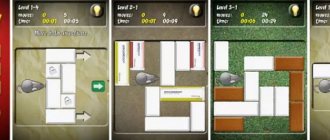Switch layout from menu bar
The right side of the macOS menu bar at the top of the screen plays a role similar to the system tray area in Windows. Here system information about time, date, network connection and the keyboard layout we need is displayed.
Language switching icon on the top menu bar
The current input language is indicated by the location country flag. The international keyboard, with the standard English QWERTY layout, is designated by the letter "A" by default. For convenience, it can be replaced with the flag of an English-speaking country. Clicking on the layout icon displays the pop-up menu shown in the screenshot, containing four sections:
- switch input language, the current one is indicated by a tick;
- display the on-screen keyboard or panel for typing emoticons and additional Unicode characters;
- highlighting the current layout; the name specified in the first paragraph will be displayed next to the flag in the menu bar;
- section of the operating system settings responsible for assigning keyboard parameters.
Input Sources Menu
By calling this menu, you can use the first section to change the input language from English to Russian and vice versa.
How to change the interface language in Mac OS
Changing the language on Mac OS is possible at any time. There is no need to install additional languages - they are all included in the system. All you need to do is set the desired language in the computer settings.
To change the interface language in Mac OS you need to:
After rebooting, the interface language of the Mac OS operating system will change to the selected one. It is important to note that most programs that have a language option will also change their interface to the selected language, if they support it.
Switching layouts using hotkeys
Using keyboard shortcuts is a faster and more convenient way to switch layouts. This option is used by most users. On all Mac computers running macOS Sierra or a newer version of the OS, you can use the keyboard shortcut Control + Space to switch the input language. In the screenshot they are indicated in red. Earlier versions of macOS released before 2020 used the Command button instead of Control.
Keys used in macOS to change layouts
After checking these two standard keyboard shortcuts, we determine which option is used on our computer.
Changing hotkey combinations
The change in standard keyboard shortcuts described above is caused by the appearance of the Siri voice assistant in macOS. To quickly call it, Cupertino engineers reserved the Command + Space combination in the system. This is where the force of habit comes into play. Some will agree with the keyboard shortcut proposed by Apple, while others will want to return everything to the way it was before. If you belong to the second category of users, go to the keyboard settings section. To do this, you can use the top line menu item described earlier or open general system settings:
- Select the section indicated by the frame in the screenshot.
Keyboard options in system settings
- Having opened the keyboard settings parameters, in the top menu of the window, select the tab shown with the number “1”. On the left side we find the “Input Sources” section. On the right side of the window, select the item responsible for changing the input source. By clicking on the area indicated by the arrow, we activate the window with the keyboard shortcut. The screenshot shows how to change the standard system combination to the one previously used in macOS.
Changing the keyboard shortcut
Setting up language change
- Find the apple icon at the top left and click on it. Select “System Settings” from the drop-down list.
- In the window that appears, we see the “Language and Region” shortcut, click.
- A window appears where in the “Preferred languages” item there is a list of options that can be switched using keyboard commands.
- If Russian (or other required) language is not there, you need to click on the “plus” and add it.
- If you set Russian as the default language, all elements of the Mac OS interface will be displayed in it. But in order for this function to take effect, you must restart the computer.
- We check whether the hot keys work: Cmd+space and Ctrl+space.
Using Caps Lock to change layout
The macOS operating system provides another option for changing the layout. Some may find it even more convenient than the standard methods discussed above.
In the keyboard settings, switch to the “Input Sources” section. The arrow indicates a menu item that activates switching by pressing the Caps Lock key. By checking the box, you can select the desired language with one key.
Activating Caps Lock to switch input language
Switching to uppercase characters will not go away. A simple press of the key once will change the layout, and pressing and holding allows you to enter in capital letters. Working in uppercase, as usual, will be indicated by the green indicator built into the Caps Lock button.
What languages are available on Mac OS
Apple sells its devices almost all over the world. To gather the maximum audience of users, the Cupertino corporation is trying to localize its services and operating systems as much as possible. The interface of the Mac OS operating system is available in dozens of different languages, in almost all modern languages.
Please note: Among the languages that Mac OS can run in, there are many very exotic ones, for example, Tongan, Telugu, Yakut, Ekajuk and many other languages are available in the operating system.
Adding an additional language pack
In some cases, two languages installed in the operating system may not be enough. For example, you need to write a letter in Spanish. Some of the letters of its alphabet contain additional diacritics that are not found in the standard Latin layout.
- Open the keyboard settings. Go to the “Input Sources” section. Use the “+” symbol indicated by the arrow to open the dialog for adding keyboard layouts to the system.
Adding a new language
- The left side of the pop-up window lists the language packs available for installation. We find the one we need among them. Having selected it, we see the layout on the right side. Indicated by the number “2” is standard for Apple computers. We mark it and complete the action by clicking the “Add” button.
Selecting a layout for a new language
Using Punto Switcher to switch input sources
Knowing how to change the input language on a MacBook using standard means, let's consider the option of using third-party software for this purpose. The Punto Swither program was developed specifically for automatically changing the keyboard layout. Its algorithms are based on so-called “impossible combinations” of letters. By detecting them, the program automatically changes the language and converts incorrectly typed text.
- You can download the latest version of Punto Switcher to install on your Mac from the servers of Yandex, which is the owner of the program.
It is distributed as an archive containing a standalone installer in PKG format. Punto Switcher installer menu - At the final stage of installation, the program provides configuration recommendations.
By clicking on the marked button, we go to the security section of the operating system. The last step of installing Punto Switcher - The “Universal Access” area opens on the left side of the window.
The programs included in it are considered trusted and are allowed to control the computer. To add Punto Switcher you need to click on the “+” icon and select it from the list of installed ones. The switch opposite the program icon must be checked. Thus, we allow it to automatically start when the operating system starts and control the switching of layouts. Adding permission to manage the system - The Punto Switcher icon will appear on the top menu bar. By clicking on it, we expand the main settings. We check that the automatic switching mode is turned on.
Punto Switcher icon and menu
After completing these steps, the program will begin to perform its task, changing the language layout depending on the entered text.
>In conclusion
These tips and tricks for setting up keyboard shortcuts in macOS will help you customize the system to suit you, while avoiding common mistakes.
How to switch layout with three languages installed
After installing an additional layout into the system, the user may encounter an unpleasant surprise. Changing layouts using hotkeys is performed only between the last two languages. Switching must be done using the drop-down menu on the top line. However, before sinning on the imperfection of the OS, let's figure out what's going on.
Using the OSD Menu
The standard switching option will work, but slightly differently. If you hold down the Command key and then press the space bar, an additional menu will appear on the screen with a list of installed languages.
OSD menu for switching layouts
Each repeated press of the spacebar leads to a sequential search of layouts.
Advanced layout change option
Not everyone likes the option of switching using the on-screen menu. Meanwhile, macOS already provides a ready-made solution. There is a special combination for quickly changing layouts when installing three or more language packs:
- Open the OS settings and go to the keyboard settings section.
- We find the tab in which we changed the hot keys. The number “three” indicates a keyboard shortcut that allows you to change the input language without displaying an additional menu.
Input source selection menu
When using the combination indicated in the screenshot, a sequential transition between language packs is performed, accompanied by a change of flags in the top line of the system menu.
Switch language on macOS
First of all, we note that by changing the language, users can often mean one of two completely different tasks. The first relates to changing the layout, that is, the direct text input language, the second – to the interface, more precisely, its localization. Each of these options will be discussed in detail below.
Option 1: Changing the input language (layout)
Most domestic users have to use at least two language layouts on their computer - Russian and English. Switching between them, provided that macOS already has more than one language activated, is quite simple.
- If the system has two layouts, switching between them is carried out by simultaneously pressing the “COMMAND+SPACE” (space) keys on the keyboard.
If more than two languages are activated in the OS, you need to add one more key to the combination indicated above - “COMMAND+OPTION+SPACE”.
Important: The difference between the key combinations “COMMAND+SPACE” and “COMMAND+OPTION+SPACE” may seem insignificant to many, but this is not so. The first allows you to switch to the previous layout, and then return to the one used before it. That is, in cases where more than two language layouts are used, using this combination, up to the third, fourth, etc. you'll never get there. This is where “COMMAND+OPTION+SPACE” , which allows you to switch between all available layouts in the order they were installed, that is, in a circle.
In addition, if two or more input languages are already activated in macOS, you can switch between them using the mouse, literally in two clicks. To do this, find the flag icon on the taskbar (it will correspond to the country whose language is currently active in the system) and click on it, and then in the small pop-up window, left-click the mouse or trackpad to select the required language.
Which of the two methods we have outlined to choose to change the layout is up to you to decide. The first is faster and more convenient, but requires memorizing the combination, the second is intuitive, but takes more time. Troubleshooting possible problems (and this is possible on some OS versions) will be discussed in the last part of this section.
Changing the keyboard shortcut Some users prefer to use keyboard shortcuts other than those installed by default in macOS to change the language layout. You can change them in just a few clicks.
- Open the OS menu and go to System Preferences.
In the new window, navigate to the “Keyboard Shortcuts” tab.
In the left side menu, click on the “Input Sources” item.
Select the default shortcut by pressing LMB and enter (press on the keyboard) a new combination there.
Note: When setting up a new key combination, be careful not to use the one that is already used in macOS to call any command or perform certain actions.
This is how you can easily and effortlessly change the key combination to quickly switch language layouts. By the way, you can swap the hotkeys “COMMAND+SPACE” and “COMMAND+OPTION+SPACE” in the same way. For those who often use three or more languages, this switching option will be much more convenient.
Replacing the Russian Apple keyboard with a PC layout
A feature of the Apple keyboard that not all users can adapt to is the order in which punctuation marks are entered. The period and comma in the standard Russian layout are located in the number row. In the familiar PC keyboard used on Windows computers, these punctuation marks are entered from the bottom letter line.
We go to the keyboard settings and perform actions similar to adding an additional language pack. Having selected the Russian language, add the “Russian - PC” layout. The resulting changes are visible on the keyboard thumbnail. After the letter “u” we have a dot. When switching case, use the same key to enter a comma.
Replacing the Russian language layout
The only unpleasant moment is the displacement of the letter “е” from the middle letter row to the upper left corner of the keyboard. Considering how little it's used it won't be too much of a problem when typing.

